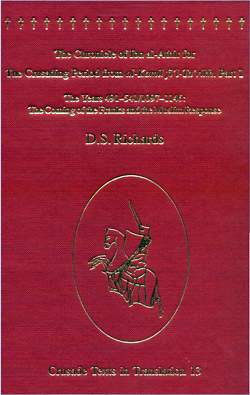
De Re Militari | Book Reviews
D.S. Richards (trans.)
The Chronicle of Ibn al-Athîr for the Crusading Period from al-Kâmil fî’l-ta’rîkh, Part 2.
The Years 541-589/1146-1193: The Age of Nur al-Din and Saladin
Crusade Texts in Translation 15. Aldershot, Hampshire: Ashgate, 2007. Pp. vii, 437. ISBN 978-0-7546-4078-3.

For crusade historians hard-pressed to find untapped medieval sources on holy war outside of the oft-quoted and long-translated canon of Western European chronicles, Muslim accounts provide a fresh and often less jaundiced view of military and political events than their Catholic counterparts. The only drawback for Western scholars in accessing this rich font of crusading evidence is its language of composition, Arabic. Besides florilegia of Muslim chronicle accounts published by such scholars as Francesco Gabrielli, Arab Crusaders of the Crusades (1984) and Amin Maalouf, The Crusades through Arab Eyes (1985), Western crusade historians have had few opportunities to adequately utilize the rich chronicle literature of the invaded populations of the twelfth- and thirteenth-century Middle East until D.S. Richards, retired Lecturer in Arabic at the Oriental Institute (Oxford), undertook the momentous task of translating into English sizeable portions of the twelve-volume chronicle, al-Kâmil fî’l-ta’rîkh, penned by one of the most perceptive observers of the first century of crusading, Ibn al-Athîr (1160-1233). Springing from a family well-known in cultural and government circles during the last decades of the Saljuq sultanate and afterwards, Ibn al-Athîr had access to both history and rumor at the highest level of Middle-Eastern society throughout much of the late-twelfth and early-thirteenth centuries.
The second volume of Richards’s translation [see review of vol. 1 here - ed.], on which this review will focus, is roughly bound by the years of the Second and Third Crusades. Since Ibn al-Athîr takes a holistic view of Islam and the lands in which it flourished (dar al-Islam), he arranges his chronicle by year, then treating in turn the events of Muslim communities ranging from Spain to North Africa, Syria, Iran, Iraq, and finally to the territories of the Holy Land which had recently been transformed into the Latin Kingdoms. Though producing a broad view of Muslim economic and intellectual life in the pages of his chronicle, Ibn al-Athîr takes as his principal theme the monumental struggle between Muslim polities across the Mediterranean and the Western barbarians or ifranji who were successfully challenging Muslim power from Spain to Palestine. He pays particular attention to great battles such as Hattin (July 4, 1187)and provides pen portraits of the greatest warriors and rulers of the era; namely, Saladin and Richard I “the Lionheart”. These accounts are invaluable for understanding how the European base in the Middle East was lost and how these disputes of the period presaged the unhappy relationship of European nations and Muslim territories throughout the twentieth century and into the twenty-first.
This beautifully translated, edited, and produced set (eventually to
appear in three volumes) is a critical addition to medieval studies and
deserves to be in the library of any student of crusade and Middle Eastern
history.

Donald J. Kagay
Albany State University <[email protected]>
Page Added: May 2008